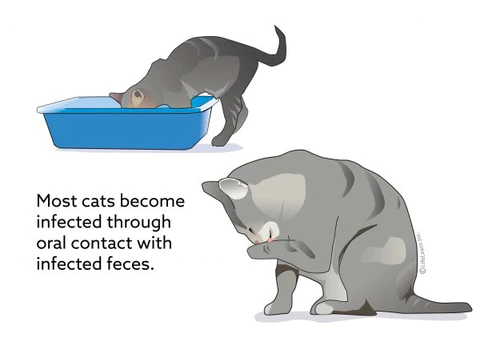1. What is FIP, a preliminary introduction to FIP
Feline diarrhoea, the full name of feline infectious peritonitis (FIP), is a multi-system disease syndrome caused by the mutation of feline coronavirus (FCoV) and the inflammatory response of the whole body or some organs.
This systemic inflammatory response results in pyogranulomatous lesions in multiple organs, fever unresponsive to antibiotics, and accumulation of viscous yellow fluid in the abdomen or chest. This process usually lasts for weeks or months, and finally leads to the death of the cat.

X-ray of feline-to-abdominal cat: 1Diffuse opacity due to lower pleural effusion, 2Heart without borders visible due to pleural effusion, 3Trachea, 4Lungs (only a small part still ventilated), 5Liver, 6 stomach, 7 intestines
2. What is feline coronavirus, and what does it have to do with cat-abdominal transmission?
Some people may be more curious, why FIP is caused by a mutation of feline coronavirus, why not other viruses? Do they have any special relationship?
Feline coronavirus (FCoV) is an enveloped, single-stranded RNA virus that hosts cats and is ubiquitous throughout the world. Feline coronavirus is divided into two types, one is feline enteric coronavirus (FECV) that infects the intestinal tract, and the other is feline infectious peritonitis virus (FIPV) that causes feline infectious peritonitis.

3. How is feline enteric coronavirus transmitted and how do cats get infected?
The virus primarily infects and replicates in the intestinal tract, but also in the oropharyngeal tissues early in infection. The virus begins to be excreted in saliva and feces within 1 week of infection and survives for days to weeks. The cycle of virus excretion through saliva is relatively short, generally lasting from a few hours to a few days, and a high level of detoxification can be sustained for 2-10 months through feces, and then a longer period (up to 24 months) of continuous or intermittent Sexual low-level detoxification.
Cats are infected by ingesting or inhaling virus-containing feces through the mouth or nose, or by contact with items contaminated with the virus. It is estimated that 25% to 40% of domestic pet cats will be infected with FeCV, but in environments with multiple cats, such as multi-cat households, pet stores, catterys, etc., cats often share litter boxes, tableware and other items, and the infection rate Will increase to 80% ~ 100%.

Cats become infected by ingesting or inhaling virus-containing feces through the mouth and nose
4. Will cats carry it for life after being infected with enteric coronavirus?
Cats infected with FeCV typically mount an immune response, producing antibodies within 7-10 days of infection. Studies have shown that households with fewer than five cats eventually shed the coronavirus spontaneously.
Once a cat becomes infected with the virus and recovers, cats can easily become reinfected through continued exposure to infected feces, and households with more than five cats are almost never cleared of coronavirus. Many catteries, or multi-cat households, always have cats sharing litter boxes, so are never free from the infection, and at least 13% of infected cats will shed the virus indefinitely.
5. What are the symptoms of cats infected with coronavirus?
Although cats are easily infected with feline enteric coronavirus, there is no need to panic, because feline enteric coronavirus is relatively mild, and most infected cats will not show clinical symptoms, and some may cause mild self-limiting (that is, Commonly known as self-healing) gastroenteritis, which leads to diarrhea. Some kittens with weakened maternal antibodies may induce severe enteritis.
6. How to diagnose whether a cat is infected with enteric coronavirus?
Viral DNA of feline enteric coronavirus can be detected in feces by RT-PCR (also known as fecal reverse transcription polymerase chain reaction).
7. How to treat cats infected with enteric coronavirus?
Most cats do not show any clinical signs and do not require treatment. Treatment is also symptomatic and supportive (ie, fluid therapy, oral electrolyte solution, antiemetics, antidiarrheals) if needed.
At present, there is no specific antiviral therapy, and we can only rely on our own immune system to clear the virus. There is no need to worry about the death of cats from gastrointestinal problems caused by the virus, as deaths from FECV-associated gastroenteritis are uncommon.
8. How to kill feline enteric coronavirus?
Feline enteric coronavirus is a relatively fragile virus that is destroyed by most household disinfectants and cleaners. However, it can survive outside the cat’s body for up to 7 weeks in cold environments or in dry conditions, such as in carpet.
We only need to use diluted bleach (1 part bleach to 32 parts water) to kill feline enteric coronavirus in the environment within 48 hours.

